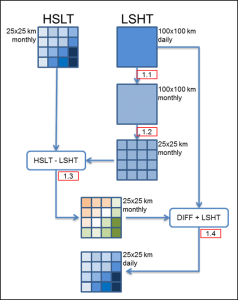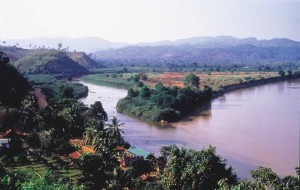In 2013 the Climate Change and Adaptation Initiative of The Mekong River Commission was developing its first report on the status of climate change in the Lower Mekong Basin. An important component of this report would be to provide information on trends in the past climate. For this a detailed and homogenous climate data set was required. Based on proven interpolation techniques it was possible to effectively combine different sets of reanalysis data, which resulted in a high spatial as well as high temporal resolution climate data set. The overall objectives of this work was (i) To develop a baseline climate database over the period 1900-2010, (ii) To undertake a trend analysis on this database.
The Mekong River Commission (MRC) has its Climate Change and Adaptation Initiative (CCAI), which is a collaborative regional effort of MRC Member Countries (Lao PDR, Cambodia, Thailand and Vietnam) to support processes of adapting to the new challenges posed by climate change in the Lower Mekong Basin. The CCAI is developing its first “Status of Climate Change in the Lower Mekong Basin” report. An important component of this report will be to provide information on trends in the past climate. For this a detailed and homogenous climate data set is required. Such a data set can also be used for other purposes like hydrological modeling and related assessments.
The need of a climate trend analysis over the past is clear. There is still a lot of uncertainty on the direction of climate change in terms of magnitude as well as spatial distribution. Not only the annual trends, but even more importantly are shifts in seasonality and changes of extremes. So far, no harmonized climate database covering the entire Mekong river basin exists.
 The number of reanalysis data products is increasing rapidly. Some of these products are strong in one region, while other performs better in other regions. Although reanalysis products are based on observations, differences might occur. The main reason is that not all observational data is included in the reanalysis datasets. Using an extensive database of meteorological observations, correction factors will be applied to the reanalysis data.
The number of reanalysis data products is increasing rapidly. Some of these products are strong in one region, while other performs better in other regions. Although reanalysis products are based on observations, differences might occur. The main reason is that not all observational data is included in the reanalysis datasets. Using an extensive database of meteorological observations, correction factors will be applied to the reanalysis data.
In general, reanalysis products with a high spatial resolution have a low temporal resolution and vice versa. Based on proven interpolation techniques it is possible to effectively combine these sets of reanalysis data, which will result in high spatial as well as high temporal resolution.
The overall objectives of this work are:
- To develop a baseline climate database over the period 1900-2010.
- To undertake a trend analysis on this database.
Related publications
2014 - FutureWater Report
Development of baseline climate data set and trend analysis in the Mekong Basin
Lutz, A., W. Terink, P. Droogers, W.W. Immerzeel, T. Piman
2014 - FutureWater Report
Development of baseline climate data set and trend analysis in the Mekong Basin. Appendices.
Lutz, A., W. Terink, P. Droogers, W.W. Immerzeel



